by Heonik Kwon
September 3, 2013
This article was originally published by the Asia-Pacific Journal, Vol. 11, Issue 32, No. 4, on August 12, 2013.
I. Introduction
Heonik Kwon writes: China and North Korea have varying and even contradictory interests in the history of their political alliance and in reviving their old revolutionary solidarity today. China’s interest in the history of Sino–North Korean revolutionary solidarity, unlike North Korea’s, is no longer based on the conception of a common enemy…China’s economy-first socialism and North Korea’s military-first socialism clearly do not look back upon the two countries’ history of revolutionary solidarity in the same way. In this regard, the contemporary state of Sino–North Korean friendship raises interesting questions about the concept of political friendship and political enmity mentioned at the outset; in particular, the question is whether the former is necessarily dependent on the latter.
Heonik Kwon is professorial Senior Research Fellow at Trinity College, University of Cambridge, and an APJ associate. The author of The Other Cold War, he co-authored North Korea: Beyond Charismatic Politics (Rowman & Littlefield, 2012) and is completing a book on intimate histories of the Korean War.
Recommended citation: Heonik Kwon, “The Korean War and Sino-North Korean Friendship,” The Asia-Pacific Journal, Vol. 11, Issue 31, No. 4, August 12, 2013.
The views expressed in this report do not necessarily reflect the official policy or position of the Nautilus Institute. Readers should note that Nautilus seeks a diversity of views and opinions on significant topics in order to identify common ground.
I. SPECIAL Report by Hoenik Kwon
The Korean War and Sino–North Korean Friendship 朝鮮戦争と中朝友好関係
The relationship between China and North Korea is a subject that attracts much discussion and speculation in today’s policy circles and media. The history of Sino–North Korean friendship is typically traced to the time of the Korean War (1950–1953), although in North Korea it tends to go further back, to the colonial period. The texture of this international friendship has been changing recently. Some Chinese leaders state that China’s friendship with North Korea is no longer a special one and that the two countries have, or should have, a “normal” interstate relationship—respecting mutual interests as well as certain international norms—rather than one that is historically determined and unchanging. In North Korea, by contrast, there has been renewed interest in reinventing its relationship with China as a historically constituted and durable friendship. This essay explores North Korea’s recent efforts to present its relationship with China as a special, extraordinary, revolutionary friendship. It will focus on how the making of this special friendship draws upon a set of powerful ideas and metaphors of kinship and consanguinity. First, however, a few words on kinship and friendship concepts.
Friendship and kinship
In the history of anthropological research, studies of human friendship have developed in close interaction with those of human kinship relations. Kinship is a milieu of relations we are born into, thus making up ascribed and given relationships, in contrast to friendship, which is something we construct in the course of our lives, that is, an achieved and acquired relationship. Kinship is central to the moral and political order of a collective, particularly in small-scale tribal societies or in traditional agrarian societies—the traditional focus of anthropological research. Whereas friendship is an important aspect of personal life and interpersonal relations, the primarily personal and individual (rather than collective and social-structural) nature of friendship renders friendship relations of relatively less significance than kinship relations in traditional anthropological research. Nevertheless, in this tradition, kinship and friendship are understood as interconnected, mutually constitutive spheres of human relations. This is especially the case in the segmentary kinship theory of early British social anthropology, in which friendship is discussed as an integral part of kinship and in which friends and enemies are context-specific, shifting identities.
In sociological research, friendship has taken on a rather different significance. Here, friendship is discussed as the primary manifestation of intimate human relationship in modern individual society; that is, as an alternative in modern society to what kinship is in traditional society. It is widely assumed in this disciplinary tradition that kinship retreats in relevance during the transition from traditional community to modern society and that friendship fills the vacuum left by the retreat of kinship functions. Common to the sociological and anthropological traditions, however, is the assumption that friendship is primarily an aspect of private lives rather than of the public social order.
In political theory, the morality of friendship is discussed within a different conceptual order. Particularly in the normative theory that is strongly revived in contemporary analytical circles, friendship is an important concept, meaningful for the moral and structural basis of a democratic social and political order. The topic of how to bring out friendship-like solidarity or like-mindedness among otherwise unrelated individual actors—a subject that goes back as far as Aristotle—features prominently in the discourse of contemporary normative political theory. Here, the theory of friendship emphasizes the virtues of the common public good and the art of reciprocity. In this development, friendship is often presented as a key property of the democratic public order and frequently in contrast to the image of a social order advocated by the utilitarian philosophical tradition. This orientation also tends to distinguish friendship from fraternity, as shown in Jacques Derrida’s The Politics of Friendship. [1] In this work, Derrida strives to envision a democratic political order based on an open and broad sense of public or political friendship. He also tries to distinguish this concept of political friendship from the idea of fraternity, which Derrida sees as the invention of modern nationalism.
Political friendship is an intensely debated concept in circles of international relations theory. Focused mostly on interstate relations in the liberal international order, this analytical trend tends to define itself, on the one hand, against the traditionally dominant realist school and, on the other, against the heritage of Hobbesian political thought. It questions the assumption that states, like individuals, are prefigured to pursue their self-interests and to maximize their egoistic interests. The interest in friendship in international relations theory tends to reject the idea that the international system is a fundamentally anarchic entity (Hobbes’s “all against all” idea), characterized by the contest of power among selfish actors pursuing their narrow interests relentlessly. This theoretical interest, like the political theory of friendship mentioned briefly above, tends to highlight the ethics of reciprocity and the morality of mutuality (although in the context of interstate relations, unlike the latter). Scholars who write about friendship in international relations also tend to be critical of theories influenced by the German constitutional theorist Carl Schmitt and Schmitt’s notion of modern political sovereignty based on a radical friends/enemy dichotomy. [2] These scholars question whether the idea of friendship in international relations is necessarily dependent on this dyadic scheme of friends versus enemies and the fact that in Schmitt’s theory of the political, friends remain unjustifiably obscure and ill defined, compared to the arguably relative clarity of the concept of the enemy. [3]
What is missing in the existing studies of political friendship?
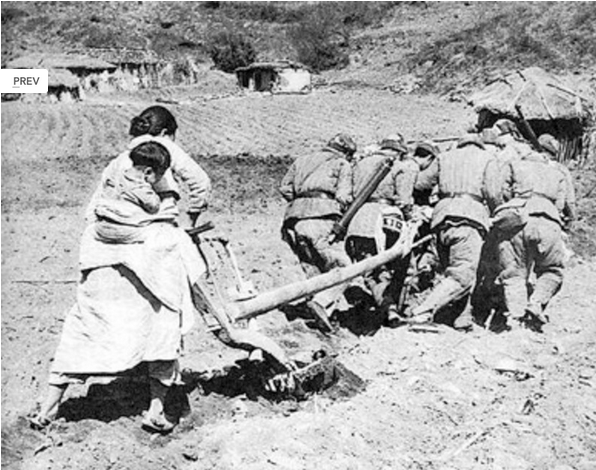
Friendship between Chinese volunteers and North Korean people depicted in Chinese People’s Liberation Army publication in 1959, Glorious Chinese People’s Volunteers.
Reading these broad existing studies of friendship and political friendship, two issues seem to stand out. One of these issues is the disparity between the anthropology of friendship and the sociology of friendship (including the scholarship of political friendship in contemporary political and international relations theories). As mentioned, the anthropology of friendship is anchored in the analytical contrast between kinship and non-kinship relations. This interest in friendship as a relationship that is conceptually paired with kinship is virtually absent in the contemporary political theories of friendship, which approach friendship, as mentioned, from the perspective of modern individualism. The other issue, noticeable in the philosophy of political friendship, is that this research domain is almost completely blind to one powerful legacy of political friendship in modern history, namely, the morality and aesthetics of revolutionary friendship, or the idea of comradeship. Instead, researches in this genre are crowded around the constitution of political order in modern liberal states and the fabrics of interstate relations among these actors. Thus, the history of socialist and communist social and political revolution since the late 19th century (and the history of the Cold War in the second half of the 20th century) is largely absent from discussions in this research sphere, despite the fact that this revolutionary history advanced a powerful morality of political friendship both domestically and in the domain of international and transnational solidarity. We need only think of the powerful musicality imbuing the spirit of internationalist friendship as depicted in the song The Internationale (written by the French poet Eugène Pottier in 1871 amidst the chaos of the Paris Commune). [4] The collective singing of this song is integral part of the organization of public assemblies that celebrate the historical solidarity and shared internationalist spirit between North Korea and China.
What follows aims to explore these two hitherto unexamined issues concerning political friendship: the conceptual ties between friendship and kinship, and the history of revolutionary comradeship in modern political thought. It shows the relevance of confronting these issues in understanding North Korea’s powerful rhetoric about international friendship with its key historical ally, China—what North Korea refers to as jojung ch’insŏn (Korean–Chinese friendship). In China, this relationship is referred to as the Chinese–DPRK youyì (友谊) or qinshan (親善).
Before proceeding, however, a brief note on how I came to take an interest in this particular revolutionary international friendship as an empirical and theoretical question. In recent work written in collaboration with a colleague in South Korea, I discussed two interrelated conceptual paradigms for understanding North Korea’s political genesis and system. [5] One of these is the idea of the “family state,” proposed by the South Korean anthropologist and veteran observer of North Korea Lee Moon-Woong. In an informative 1979 article, Lee argues that, “The ties between the masses and their supreme leader are very much like kinship relations. It is therefore appropriate to call the political system of modern North Korea a family state … The leader’s role is akin to the role of a head of household; he exercises absolute authority and is the source of all wisdom. Thus the destiny of the state resembles the fate of a family.” [6] Lee’s family state idea is instructive for understanding many aspects of North Korea’s past and present political processes. For the purpose of this essay, it suffices to mention that the idea of the family state should be understood in relation to another important political form that arose forcefully in North Korea in the era immediately after the Korean War. In a seminal study of North Korea’s political history, the eminent Japanese historian of modern Korea and the Korean War, Wada Haruki, proposes a definition of North Korea’s political system as a “partisan state” (yugekitai kokka in Japanese; yugyokdai gukka in Korean). [7] This concept draws attention to the political actors who played a central role in the foundation of North Korea in the middle of the twentieth century and to the career backgrounds of those formative actors in colonial times as members of an armed resistance group based mainly in Japanese-occupied Manchuria. One relatively small group of armed resistance fighters was led by the young Kim Il Sung and attracted considerable moral and political support from the large group of settlers of Korean origin in northeastern China. After 1945, these originally Manchurian-based armed revolutionaries were privileged over other nationalist groups in the early years of state building in North Korea after liberation from Japan’s colonial rule, with strong support from the Soviet military. During the decade after the Korean War, Kim and his former partisan group from the Manchurian era waged a vigorous power struggle against other revolutionary groups and factions. By the end of the 1950s, Kim’s Manchurian comrades had become an unchallenged, unchallengeable political force in North Korea, and the group (including their family members) remains so to this day.
One of the most cherished revolutionary songs in North Korea, Song of Comradely Love (1980), shows well the morality of revolutionary comradeship arising from the hardship of anticolonial partisan struggles:
No matter how arduous the way may be,
We shall climb over the hills of hardship.
No matter how strong the wind of fire may be,
We shall stay together in life and death.
You can’t purchase even with tons of gold,
The boundless love of comrades.
Let our resolve live forever,
Looking up at the Single Star.
In view of this song, as well as many other similar political cultural artifacts of North Korea, the issue I raise in this essay relates to whether the morality of comradeship such as that expressed in the above poem, can be extended from North Korea’s domestic political culture to the horizon of the country’s international relations. So my question is this: Do the aesthetics of the partisan-family political paradigm also shed light on Sino–North Korean historical relations?
The material culture of Sino–North Korean friendship
Two prominent material objects, among others, demonstrate the history of North Korea-Chinese international revolutionary solidarity. One of them is the Sino–North Korean Friendship Bridge on the Yalu River, along North Korea’s border with China. This place bustles with a fast-growing traffic of goods and raw material moving between the two countries. The bridge connects the city of Dandong (previously Andong), China’s border town in Liaoning Province, and Sinŭiju, one of North Korea’s northernmost towns.
The Sino–North Korean Friendship Bridge represents North Korea’s current aspiration for economic development and China’s sustained strategic interest in the stability of its old ally, which has been a quite difficult neighbor in recent decades.
The Friendship Bridge has a compelling history. Originally constructed at the end of the 1930s by the Japanese, it then connected the Korean peninsula to Manchukuo, two territories under colonial occupation, and was intended to facilitate Japan’s deeper colonial penetration into China. It was not the first modern bridge connecting Korea to China, however. Before this bridge, there was an iron truss bridge completed in 1911 with horizontal rotation capability for the navigation of large ships on the river. Both of these Yalu River bridges were destroyed in November 1950 amidst the chaos of the Korean War by United States fighter-bombers and heavy bombers. The destruction followed the entry of the Chinese volunteer army into the theater of the Korean War and was intended to cut the army’s supply line from China. The 1911 bridge remains broken, attracting a steady flow of tourists on the Chinese side. It is called the Broken Bridge, one of the key cultural heritage sites selected for recognition by the State Council of China. The bridge built in the 1930s—that is, what is today known as the Sino–North Korean Friendship Bridge—was rebuilt after the Korean War. On the Chinese side, the mouth area of this bridge has now been turned into a public park, featuring a long promenade along the river, what is known in China as the Yalu River Scenic Zone, a prime tourist attraction in northeast China. In 2010, China built another bridge further downstream.
The Sino–North Korean Friendship Bridge embodies the turbulent history of conquest, war, and revolution in northeast Asia. The history of international solidarity represented by this material object incorporates another war not mentioned above. During China’s civil war in 1946–1949, North Korea provided crucial material and logistical support for Mao’s army and partisan forces, partly by channeling Soviet military supplies to their Chinese comrades locked in battle with the Guomindang. A large number of ethnic Koreans fought shoulder to shoulder with the Chinese during this war, and, as is well known, it was the end of this war and the consequent availability of a strong contingent of Koreans from China that provided the momentum for North Korea’s invasion of South Korea in June 1950. [8]
Thus, there are three distinct histories of conflict involved in the exchanges between China and Korea conducted through the Yalu bridges. First was the expansion of Japan’s colonial and military conquest from Korea to Manchuria, which provoked forceful armed resistance by the Chinese, as well as among the Korean population in northeast China. Let’s call it the colonial-era international solidarity of resistance (which, as we will see shortly, appears prominently in the North Korean accounts of friendship with China). Second was the era of the Chinese Civil War, during which the Korean and Chinese armed groups fought hand in hand against Chiang Kai-shek’s Guomindang forces. Then came another revolutionary civil war, this time, in the Korean peninsula, in which China took part in aid of North Korea. After the Korean War ended in July 1953, a large number of Chinese volunteers stayed on in North Korea until 1958 to help rebuild the country’s devastated economy and infrastructure. During this long era, from the early 1910s to the end of the 1950s, a great number of people and a great quantity and diversity of material objects passed over the Yalu River bridges, sometimes northward and other times southward. The history of the Korean War is pivotal to the history of the Sino–North Korean Friendship Bridge, not least because it was then that the true strength of this friendship was brought to the fore, against many odds. Despite incessant assault by superior US firepower, the bridge was repeatedly repaired and rebuilt during the war. This last fact testifies to the unbreakable nature of North Korean–Chinese revolutionary solidarity, according to postwar North Korean narratives, and this “perpetual friendship” that defies all types of tests and overcomes adversity is what the Friendship Bridge is supposed to embody.
The centrality of the Korean War experience in the formation of Sino-Korean friendship is forcefully demonstrated in another built object, this time at the very heart of North Korea’s political geography in Pyongyang rather than on the peripheral border with China. Called the “Tower of Friendship,” this monument sits on a modest hill at the center of North Korea’s capital, overlooking the city’s prominent Victory Tower. Completed in 1959, immediately following the departure of the Chinese volunteer army, which had helped with Korea’s reconstruction efforts, the cenotaph underwent a major renovation in 1984. North Korean leader, Kim Il Sung, and Chinese premier, Zhou Enlai, inaugurated the original memorial, and its renovation in the 1980s, like numerous other state monumental projects of the time, was overseen by Kim’s designated successor and his eldest son, Kim Jong-Il.
The Friendship Tower (Uŭitap) in Pyongyang commemorates two things. Its primary function is as a war memorial, dedicated to the Chinese martyrs of the Korea conflict. Inside the thirty-meter-high granite memorial are kept the records of 22,700 fallen Chinese soldiers. The records include a separate book that lists the names of fallen officers of the Chinese volunteer forces, including Mao Anying, Chairman Mao’s eldest son, who was killed in action in the Korea conflict in November 1950, at the age of 28. The Friendship Tower consists of 1,025 granite and marble stones, intended to symbolize October 25th, the day the Chinese volunteer army entered the theater of the Korean War. The memorial celebrates not only the past alliance between the two countries but also their future friendship—“the continuity of Sino–Korean friendship across generations”—as frequently depicted in North Korean and Chinese media and literature about the relations between the two nations. The inscription on front of the stone memorial says:
“The martyrs of the Chinese People’s Volunteers who defeated our common enemy together with us under the banner of “Resist America, Aid Korea, Protect Family and Defend the Country”: Your eternal honor and the international friendship between the people of Korea and the people of China forged in blood shall shine over this country and this land forever.”
If the Friendship Bridge on the Yalu River provides a vital connection between the two countries and their economies today, [9] then the Friendship Tower in Pyongyang plays a pivotal role in connecting their histories and politics. The Tower is an important place to visit for Chinese state delegates to North Korea, functioning on these occasions as an equivalent to the Tomb of Unknown Soldiers that plays a key role on diplomatic exchanges in other countries. It saw a great diplomatic ceremony, joined by North Korean state officials and delegates from China, in October 2000 and again in October 2010, marking the 50th and 60th anniversaries, respectively, of Chinese participation in the Korean War. In the run-up to the Beijing Olympics, it attracted a 400,000-strong crowd who came to celebrate the Olympic torch relay from Pyongyang to Beijing. These and many other similar recent occasions demonstrate the power of a historically constituted international solidarity between the two countries, their leaderships, and their people.
The morality and aesthetics of Sino–North Korean international friendship are far from being timeless phenomenon, however. In recent negotiations between North Korea and the United States, a North Korean delegate is reported to have said to his American counterpart that, “there are no eternal enemies, nor are there eternal friends.” This statement is interesting, especially so considering that it was made during a meeting that was squarely about North Korea’s thorny nuclear armament issues. The United States, in North Korea’s domestic propaganda and its messages sent to the outside world, remains strongly hostile to North Korea and that hostility is portrayed as unchanging. It is also interesting to hear that the ephemeral nature of the China-North Korean relationship may extend to that of interstate friendship, not merely to that of enmity. The statement—if the idea of impermanent friendship extends to North Korea’s closest allies, such as China, not merely to former Soviet Russia—goes very much against what is loudly asserted in the North Korea media about its relationship with China.
From a historical perspective, relations between North Korea and China have indeed been far from perpetual friendship. Sino–North Korean relations were under great strain during the Cultural Revolution in China. The long Sino-Soviet conflicts from the late 1950s resulted in complications in international relations among many socialist revolutionary states, including North Korea (during and after the Korean War and the 1953 armistice, Mao advocated China’s “unbreakable,” “perpetual” friendship with the Soviet Union—only later did we learn how fragile this friendship actually was). Above all, the détente between China and the United States in the early 1970s and the subsequent market economic reform in China since the late 1970s, radically transformed the character and nature of Sino–North Korean relations. Since the early 1990s, especially after the death of North Korea’s founding leader, Kim Il Sung, in July 1994, North Korean and Chinese political and economic ideologies have been literally bifurcated along opposite streams: China’s economy-focused socialism versus North Korea’s sŏngun, or military-centered socialism.
Thus, the “friendship” between North Korea and China is not an unchanging, perpetual amity but involves fluctuating, malleable ties that are not immune from forces of change on regional and global scales. The most important of these changes was probably the end of the Cold War and the disintegration of the Soviet Union in the early 1990s, which resulted in the tectonic shift in interstate relations within North Korea’s familiar international habitat during the Cold War era (the loss of Soviet Russia as a key ally and provider of economic assistance; China’s opening of diplomatic and economic ties with South Korea in 1992; and consequent loss of leverage, on the part of North Korea, between China and Soviet Russia).
Friendship such as that advocated between China and North Korea is surely not an ordinary friendship. It is a particular political friendship established between particular groups of historical actors who are brought together for a common political ideal. The Sino–North Korean friendship, for North Korea, is a specific, revolutionary international friendship—an alliance of blood built on a long, common struggle against imperialism, first against the Japanese and then against the Americans. These two eras of anti-imperialist struggle have different compositions, however. The revolutionary international solidarity that arose forcefully in the later part of the nineteenth century and in the early twentieth century, as represented by the Second International, primarily involved non-state actors and groups. By the time of the Socialist International after the end of World War II and at the height of the Cold War, by contrast, le genre humain, or the unity of a progressive human race celebrated by The Internationale, had come to refer to a new sense of solidarity and friendship. This political friendship centered on newly established revolutionary states rather than merely involving struggling masses and progressive groups. As such, it was based on a certain sense of sovereignty and a related radical friend/enemy dichotomy, as discussed by Carl Schmitt during the interwar era.
If the Spanish Civil War (1936–1939) was emblematic of the ideal of international revolutionary friendship in the era of the Second International, the Korean War (1950–1953) was an exemplary manifestation of international political friendship (and enmity) in the second, post–World War II sense. North Korea’s war effort attracted strong international support from state entities in the socialist world. After the war, its economic reconstruction activities drew equally broad international support and assistance from China, the Soviet Union, and several European states in the eastern bloc. South Korea’s Korean War was an effort on an equally, if not more, international scale. It was the first United Nations war, as we know, involving foreign combatants from 16 nations or, if we include medical support, from 21 nations.
The end of the Cold War radically changed the structure of the friend/enemy dichotomy consolidated by the Korean War. Moreover, this momentous event contributed to hollowing out the ground on which the Sino–North Korean revolutionary international friendship had been based historically. How do political friends remain such when they no longer share the sense of a common enemy or no longer face the enemy in the same way as they did before? What happens to political friendship when it can no longer be pitted against a common enemy? Is the end of the Cold War the end of Sino–North Korean revolutionary political friendship?
The politics of friendship and the amity of kinship
On the contrary. The aesthetics of Sino-Korean friendship has been steadily revived since the mid-1990s, and especially in the 2000s. The background to this revival is complex. It suffices to mention in this essay that the revival relates closely to the North Korean leadership’s struggle for survival in a hostile international environment after the end of the Cold War and in face of a radical collapse of the country’s domestic economy. It also relates to the Chinese leadership’s careful consideration of its domestic and international situation, in particular, the need to minimize upheavals in its immediate regional environment that might jeopardize China’s sustained economic growth but also social stability. In this regard, some may argue that the recent revival of Sino–North Korean friendship is a manifestation of their separate yet reciprocal practical interests—in the sense of the primacy of real politics and real political interests that are much talked about in discourses of diplomatic relations, rather than necessarily in the light of the two countries’ historically rooted moral and political solidarity. In any case, the strength and durability of Sino–North Korean friendship has been the subject of intense attention in recent years, particularly in North Korea and especially since the year 2000, which marked the 50th anniversary of China’s entry into the Korean War.
Many important events have taken place recently in this context, both in China and North Korea. The revival of Sino–North Korean friendship has also been remarkable in cultural production and exchange—an important part of socialist politics and diplomacy. Many notable artifacts have appeared in this domain. Here, I will introduce only two dramatic renderings of the “unbreakable, unchangeable” international solidarity between North Korea and China based on the experience of the Korean War.
One of the most notable in this sphere is the recently made biographical drama of Mao Anying, the eldest son of Chairman Mao, who was killed in action in Korea in November 1950—by a napalm air strike from a South African bomber, in fact, close to the cave where Peng Dehuai’s headquarters of the Chinese Volunteer Army were located.
The drama is an extremely long epic narrative of the Chinese revolution—consisting of 37 chapters—centered on Mao, his family, and his relationship to his eldest son. It premiered in North Korea on November 25, 2010, the 60th anniversary of the death of Mao Anying. The year 2010 was the 60th anniversary of China’s entry into the Korean War and the year after the Year of North Korean–Chinese Friendship.
The drama is illuminating in a host of ways. It depicts how the Chinese state has decided, in the age of liberalization, to interpret the long history of the Chinese revolution. I wish to draw attention to one particular element in the epic narrative that concerns Mao Anying’s place in the Sino–North Korean friendship and his status as an internationalist war martyr. The drama’s theme song says
Many heroes were born
In the environs of the River Shang.
Whereas his body is in a foreign land,
His heart is in his homeland.
The heroic martyr,
The people admire.
As he sacrificed his life for the country,
His legacy will shine together with the sun and the moon.
Most interesting in this song is the phrase “Whereas his body is in a foreign land, his heart is in his homeland.” Toward the end of the epic drama, Anying’s father, Mao Zedong, receives Anying’s nursemaid and adoptive mother figure), Madame So (Anying’s birthmother and Mao’s second wife, Yang Kaihui, was executed by a KMT warlord in 1930.
Most interesting in this song is the phrase “Whereas his body is in a foreign land, his heart is in his homeland.” Toward the end of the epic drama, Anying’s father, Mao Zedong, receives Anying’s nursemaid and adoptive mother figure), Madame So (Anying’s birthmother and Mao’s second wife, Yang Kaihui, was executed by a KMT warlord in 1930.
Madame So makes an appeal to Mao: “Comrade Chairman, you know the saying that people return to their homeland after death. Anying is your son, but he is also my flesh-and-blood. It breaks my heart that I am not able to care for his grave … All the other martyrs are back in their homeland, including the heroic martyr Huang Juguang another prominent Chinese martyr of the Korean War, and they are buried in the martyrs’ cemetery in Shenyang. I have been there. Why can’t you do the same for Anying? Please bring him back to his homeland. Please bring him back next to his mother!”
Hearing this, Mao, trying to console Madame So, says, “Anying has to stay in Korea together with other martyrs. This has huge significance. This is the decision of our organization … I received a telegram from President Kim Il Sung in which he said that Anying sacrificed his life for the liberation of the Korean people. Thus, he is the Korean people’s son, he said, and he demanded that Anying’s remains stay in Korea forever so to demonstrate the friendship between China and North Korea.” Later, the drama introduces two Koreans, a grandmother and her orphaned granddaughter, who are caring for the grave of Mao Anying on a daily basis. The Korean grandmother says to some soldiers of the Chinese volunteer army who have come to visit the grave, “If you see Chairman Mao, please tell him not to worry about Anying. Please tell him I will take care of his grave and after me my descendants will be taking care of it, generation after generation.”
Several interesting issues are raised by this episode. Here we focus on the construction of a powerful amity of kinship between the Chinese volunteer soldiers and the people of North Korea, as demonstrated by acts such as the Korean grandmother and her granddaughter’s adoptive ties of kinship with Mao Anying. The North Korea–Chinese Friendship Tower in Pyongyang is inscribed with the following statement: “Our relationship is an inseparable relationship of revolutionary fraternity; it is a blood-based, consanguinal relationship” (“피로써 맺어진 혈연적 관계”). The propensity to render the blood alliance of war between China and North Korea to a notion that is far more literal in meaning, akin to a “real” consanguinal relationship, is powerfully shown in North Korea’s many other cultural and literary renderings of the Sino–North Korean relationship. In the story of Anying, it is rendered through acts of commemoration—in the light of Korea’s traditional family-based custom of ancestral veneration. In other narratives, the relationship takes on a much more literal act of sharing blood and thereby becoming a “real” consanguinal relationship.
An example can be seen in the famous epic narrative Beyond Time (“세월은 흘러도”), a story of North Korea’s eminent female war hero An Ok Hee. A mother of a child and the wife of a North Korea’s People’s Army officer who is away from home, An provides shelter to a Chinese volunteer soldier, Lee, who is being pursued by the Americans. Later, when hounded herself by the Americans, she is wounded and survives thanks to a blood transfusion offered by Lee. The Chinese soldier is then captured by the Americans during an important mission, and An volunteers for a highly dangerous mission in the hope of rescuing him. She dies heroically in the rescue attempt. In other representational contexts, it is Chinese volunteer soldiers who receive the gift of blood from North Korean civilians, mostly young married women (as in another well-known narrative featured in Flowers on the Hill).
The relationship between Lee and An has an interesting added element. Before Lee sets out on his mission, his mother arrives from northeast China to see her son. Madame An joins the reunion, and Lee’s mother discovers that her late husband once fought together with An’s father-in-law in the anti-Japanese armed struggle in Manchuria. This way, the revolutionary blood ties of the Korean War between China and North Korea appear to have their own deep genealogical history, traceable back to colonial times. In this regard, the Korean and Chinese families appear to be linked in a relationship of reciprocity (An’s family once helped Lee’s family for the Chinese revolution, and Lee then comes to help An’s homeland for the Korean revolution). They also share the proud history of defeating together two powerful imperial enemies, Japan and the United States. The Korean woman An and the mother of the Chinese volunteer soldier create a metaphorical-yet-rhetorically-real kinship relationship, and this reaches its sublimation when An Ok Hee is invited to acquire the status of daughter-in-law by the mother of the Chinese volunteer soldier.
CONCLUSION
On October 25, 2010, on the 60th anniversary of the entry of the Chinese volunteer army into Korea to aid North Korea, a large gathering took place in Pyongyang in the presence of a number of war veterans and army officers of the two countries. In this ceremony, the then vice-chair of North Korea’s powerful military commission, Kim Young-Chun, said, “Our friendship between Korea and China grew out of the revolutionary friendship of the previous generations, forged in blood in our anti-imperialist struggle for socialism and self-determination. Korea–China friendship has triumphed over many hardships and storms of history; let us promote it to a higher level according to the aspirations of the peoples of the two countries.” In reply, the Chinese counterpart said, “Our countries share rivers and mountains. My hope is that Sino-Korean friendship will continue to prosper. I hope that the two countries will continue to prosper and that our brotherly people of North Korea will enjoy a happier life.”
The above discussion raises the following tentative points:
First, China and North Korea have varying and even contradictory interests in the history of their political alliance and in reviving their old revolutionary solidarity today. China’s interest in the history of Sino–North Korean revolutionary solidarity, unlike North Korea’s, is no longer based on the conception of a common enemy. The economic interdependence between China and US has grown exponentially during the past two decades, although geopolitical tensions between the two countries continue to affect the regional order in northeast and southeast Asia. As indicated in the exchanges cited above, China’s economy-first socialism and North Korea’s military-first socialism clearly do not look back upon the two countries’ history of revolutionary solidarity in the same way. In this regard, the contemporary state of Sino–North Korean friendship raises interesting questions about the concept of political friendship and political enmity mentioned at the outset; in particular, the question is whether the former is necessarily dependent on the latter, as rendered in the constitutional theory of Carl Schmitt.
For China, moreover, the idea of international friendship is closely tied to the idea of inter-ethnic friendship in the domestic sphere, which is not the case in North Korea. China is heavily promoting an ethic of political friendship, particularly in relation to the country’s diverse national and ethnic groups, in the hope of integrating the latter into its political order. Although North Korea is not a multi-ethnic society and hence does not share China’s strong concerns about political integration within the domestic sphere, its relationship with China is also strongly affected by the imperatives of its own domestic politics, the most important factors of which are the continuity of the given political order without risk of rupture and the related need to perpetuate the authority of the polity’s founding leader.
A certain interconnectedness between domestic politics and international relations is also to be found in North Korea’s mode of displaying political friendship. Notable in this regard is the interplay between idioms of kinship and norms of friendship or comradeship. This aspect is strongly present in nearly all major North Korean renderings of its revolutionary friendship with China. In order to come to terms with the politics of friendship between these two countries, particularly those on the North Korean side, then, it is necessary to approach friendship and kinship as interrelated, rather than separate, domains of value, and, at the same time, to attend to the particularity of friendship based on a history of common revolutionary struggle. The North Korean song, The Song of Korean–Chinese Friendship, says:
We are faithful brothers, blood-sharing comrades.
Our heart keeps intensely the amity of Korean–Chinese Friendship.
For our common purpose, hand in hand,
We march in step with each other, singing our song of friendship.
Finally, let us go back to Chairman Mao’s dialogue with the nursemaid of his children, Madame So. We can only marvel at Kim Il Sung and his close comrades from the Manchurian era for their remarkable skill in appropriating the morality of kinship for purposes of revolutionary political mobilization. They succeeded in building a powerful family state whose fundamental structure and vitality continue to this day, despite heavy odds against it. They also succeeded in laying the ground for an enduring, powerful international alliance based again on the ethics of kinship. In his telegram to Mao, Kim Il Sung said, “Anying’s remains should remain in Korea forever so that it can demonstrate the power of friendship between China and Korea.” Sixty years later, the grave of this fallen soldier once again has become a vital site of diplomatic politics between North Korea and China, and an important pilgrimage destination for North Korean youth.
III. References
[1] Jacques Derrida, The Politics of Friendship (London: Verso, 2006).
[2] Carl Schmitt, The Concept of the Political (Chicago: University of Chicago Press, 1996 927).
[3] See Felix Berenskoetten, “Friends, there are no friends?: An intimate reframing of the international,” Millennium: Journal of International Studies, 2007, vol. 35, no. 3, pp. 647–676. Also Richard Ned Lebow, A Cultural Theory of International Relations (Cambridge: Cambridge University Press, 2008).
[4] The refrain of this song goes:
So comrades, come rally
And the last fight let us face
The Internationale unites the human race(C’est la lutte finale
Groupons-nous et demain
L’Internationale
Sera le genre humain)
[5] Heonik Kwon and Byung-Ho Chung, North Korea: Beyond Charismatic Politics (Lanham, MD: Rowman and Littlefield, 2012).
[6] Moon-Woong Lee, Bukhan jŏngch’imunhwaŭi hyŏngsŏnggwa gŭ t’ŭkjing The formation and characteristics of North Korean political culture (Seoul: Institute of National Unification,1979). See also Seong-Bo Kim, “Bukhanŭi juch’esasang, yuilchejewa yugyojŏk jŏnt’ongŭi sanghogwangye Confucian tradition, juch’e ideology, and personality cult in North Korea,” Sahakyŏngu Journal of the historical society of Korea 61 (2000): 234–52.
[7] Haruki Wada, Kita Chōsen: Yūgekitai kokka no genzai North Korea’s partisan state today(Tokyo: Iwanami shoten, 1998).
[8] See Zhihua Shen, Mao, Stalin and the Korean War: Trilateral Communist Relations in the 1950s (New York: Routledge, 2012), 127–130; Charles K. Armstrong, Tyranny of the Weak: North Korea and the World, 1950–1992 (Ithaca: Cornell University Press, 2013), 20.
[9] See Adam Cathcart and Christopher Green (eds.), The Tumen Triangle Documentation Project: Sourcing the Chinese–North Korean Border, Issue 1, Sino–NK, April 2013. Available online at this site.
[10] See Uradyn Bulag, Collaborative Nationalism: The Politics of Friendship on China’s Mongolian Frontier (Lanham, MD: Rowman & Littlefield, 2010).
IV. Nautilus Invites Your Responses
The Nautilus Peace and Security Network invites your responses to this report. Please leave a comment below or send your response to: nautilus@nautilus.org. Comments will only be posted if they include the author’s name and affiliation.


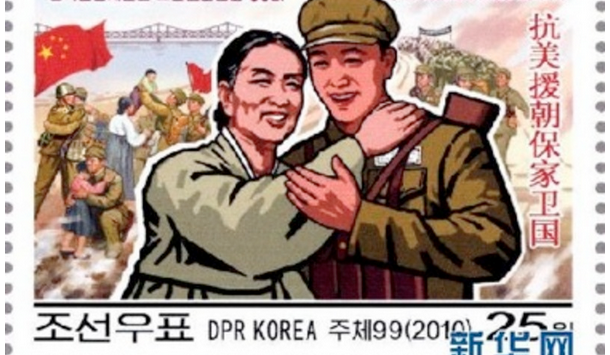
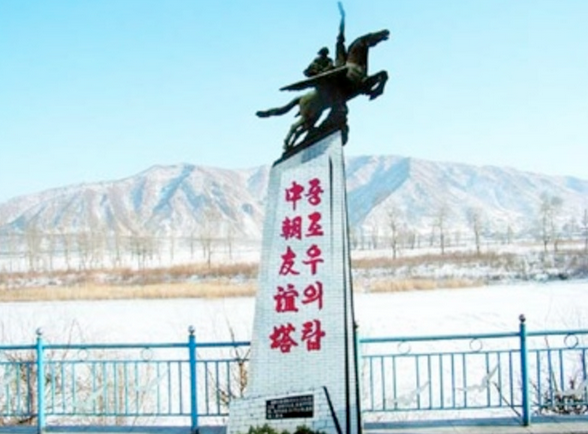
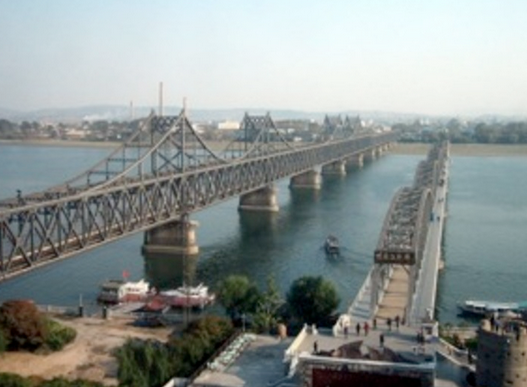
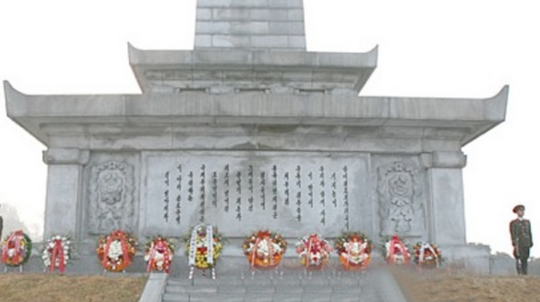
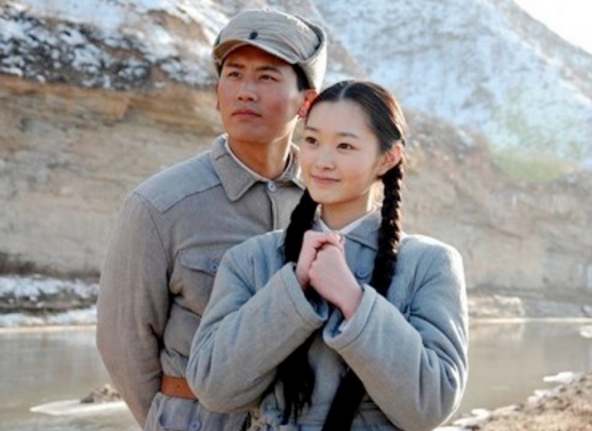
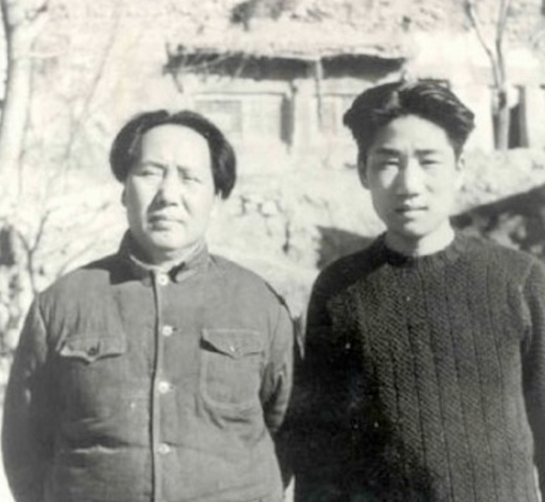
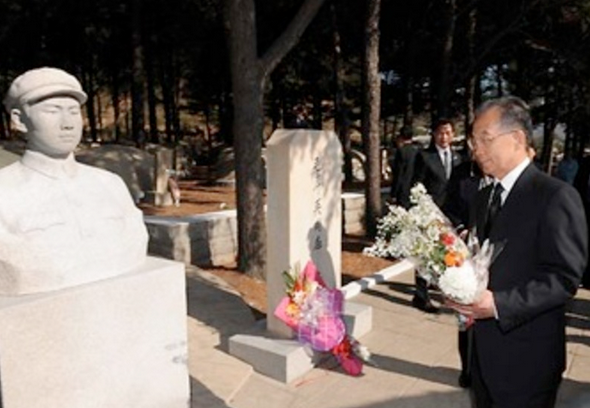
One thought on “The Korean War and Sino–North Korean Friendship 朝鮮戦争と中朝友好関係”